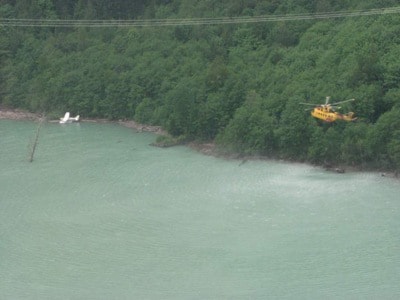The Joint Rescue Co-ordination Centre in Victoria received a 406 beacon distress call in the early morning of May 30.
Because the beacon was registered it provided instantaneous identification of the registered user and its location. They were able to ascertain exactly what the aircraft looked like and who the pilot should be.
442 Squadron at CFB Comox was tasked by JRCC and launched both the CC-115 Buffalo and the CH-149 Cormorant. They went looking for a white Cessna, yellow and black trim, with a black whale painted on the tail.
The Buffalo picked up a strong ELT signal at Harrison Lake, near Harrison Hot Springs. Being first on scene, they established communication with the pilot who said he was OK and was sitting in his aircraft. He had suffered a hard landing, damaged his floats and wasn’t able to fly.
It was determined the pilot, despite saying he was uninjured, required a medical assessment. The helicopter hoisted the Search and Rescue Technicians to the shore and they walked over to the aircraft.
The pilot appeared to have non-life-threatening injuries so all were hoisted into the hovering helicopter, they proceeded to Abbotsford and transferred care to BC Emergency Medical Services.
The aircraft commander, Capt. Justin Olsen, described the weather near the Hot Springs, “400-foot ceilings with good visibility below so they took extra time to avoid the power lines.”
The Cormorant crew was Olsen, Aircraft Commander, Lieut. Chris Carter, First Officer, Sgt. Neil Thorne and Cpl. Will Kerby, Flight Engineers, Sgt. Aaron Bygrove and MCpl. Sam Chenelle-Pepin, SARTechs.
— 442 Squadron
